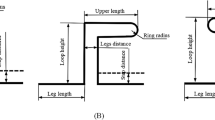Abstract
The purposes of this study were to evaluate the effects of different preactivation bends on the force system and the mechanical stresses of beta-titanium T-loop orthodontic springs. A tridimensional T-loop spring finite element model was built aiming to obtain reactive forces and moments in the three directions (x, y and z) as well as the moment–force ratios (M/F) for the sagittal and occlusal planes considering different gable bends. Using a transducer designed to measure forces in the x- and y-axis and moment around the z-axis, experimental tests were performed to validate the numerical analysis. It was observed that F x increases as the angle between extremities increases. The F x magnitude changed from 0.2 to 2.0 N. F y forces presented very low magnitude while in z direction they were null. In the sagittal plane, decreasing the gable bends increases the M/F ratio. On the other hand, in the occlusal plane, no change in the M/F ratio values was observed with the variation of the gable bends. The results obtained from the analyses showed that the M/F ratio presented different values because of different preactivation bends formed between alpha and beta extremities, consequently different types of dental movement can be produced. In the occlusal plane, no movement tendency was observed while in the sagittal plane there was a movement tendency to produce uncontrolled tipping, controlled tipping, translation and finally root correction. Translation tendency was observed during deactivation starting at 5.0 mm without crown rotation.
















Similar content being viewed by others
References
Chen J, Bulucea I, Katona TR, Ofner S (2007) Complete orthodontic load systems on teeth in a continuous full archwire: the role of triangular loop position. Am J Orthod Dentofacial Orthop 132(e1–143):e8
Caldas SGFR, Martins RP, Galvão MR, Vieira CIV, Martins LP (2011) Force system evaluation of symmetrical beta-titanium t-loop springs preactivated by curvature and concentrated bends. Am J Orthod Dentofac Orthop 140:e53–e58
Ferreira MA, Oliveira FT, Ignácio SA, Borges PC (2005) Experimental force definition system for a new orthodontic retraction spring. Angle Orthod 75:368–377
Ferreira MA (1999) The wire material and cross-section effect on double delta closing loops regarding load and spring rate magnitude: an vitro study. Am J Orthod Dentofac Orthop 115:275–282
Menghi C, Planert J, Melsen B (1999) 3-D experimental identification of force systems from orthodontic loops activated for first order corrections. Angle Orthod 69:49–57
Manhartsberger C, Morton JY, Burstone CJ (1989) Space closure in adult patients using the segmented arch technique. Angle Orthod 59:205–210
Burstone CJ, Hanley KJ (1985) Modern edgewise mechanics segmented arch technique. University of Connecticut Health Center, Farmington
Chen J, Chen K, Katona TR, Baldwin JJ, Arbuckle GR (1997) Non-linear large deformation FE analysis of orthodontic springs. Bio-Med Mater Eng 7:99–110
Raboud D, Faulkner G, Lipsett B, Haberstock D (2001) Three-dimensional force systems from vertically activated orthodontic loops. Am J Orthod Dentofac Orthop 119:21–29
Katona TR, Le YP, Chen J (2006) The effects of first- and second-order gable bends on forces and moments generated by triangular loops. Am J Orthod Dentofac Orthop 129:54–59
Katona TR, Isikbay SC, Chen J (2014) An analytical approach to 3D orthodontic load systems. Angle Orthod 84:830–838
Maia LGM, Maia MLM, Monini AC, Vianna AP, Gandini LGG Jr (2011) Photoelastic analysis of forces generated by T-loop springs made with stainless steel or titanium-molybdenum alloy. Am J Orthod Dentofac Orthop 140:e123–e128
Baeten LR (1975) Canine retraction: a photoelastic study. Am J Orthod Dentofac Orthop 67:11–23
Caldas SGFR, Martins RP, Viecilli RF, Galvão MR, Martins LP (2011) Effects of stress relaxation in beta-titanium orthodontic loops. Am J Orthod Dentofac Orthop 140:e85–e92
Coimbra MER, Penedo ND, Gouvêa JP, Elias CN, Araújo MTS, Coelho PG (2008) Mechanical testing and finite element analysis of orthodontic teardrop loop. Am J Orthod Dentofac Orthop 133:188.e9–188.e13
Ferreira MA, Assumpção R, Luersen MA, Borges PC (2013) Mechanical behaviour of a prototype orthodontic retraction spring: a numerical-experimental study. Eur J Orthod 35:414–420
Rubin C, Krishnamurthy E, Capilouto E, Yi H (1983) Clinical science: stress analysis of the human tooth using a three-dimensional finite element model. J Dent Res 62:82–86
Burstone CJ, Pryputniewicz RJ (1980) Holographic determination of centers of rotation produced by orthodontic forces. Am J Orthod Dentofac Orthop 77:396–409
Kumar YM, Ravindran NS, Balasubramaniam MR (2009) Holographic analysis of the initial canine displacement produced by four different retraction springs. Angle Orthod 79:368–372
Rodrigues FRM, Borges PC, Luersen MA, Ferreira MA (2014) Three-dimensional analysis of an orthodontic delta spring. Rev Bras Eng Bioméd. doi:10.1590/rbeb.2014.022
Gajda S, Chen J (2012) Comparasion of three-dimensional orthodontic load systems of different commercial archwires for space closure. Angle Orthod 82:333–339
Kojima Y, Fukui H (2012) Numerical simulations of canine retraction with T-loop springs based on the updated moment-to-force ratio. Eur J Orthod 34:10–18
Gadja S, Chen J (2012) Comparison of three-dimensional orthodontic load systems of different commercial archwires for space closure. Angle Orthod 82:333–339
Xavier TA, Ballester RY (2013) A comparison between the capacity of 2D and 3D finite element models in analyzing the stress distribution in shear and microshear bond strength tests. J Res Dent 1:41–54
Kuhlberg AJ, Burstone CJ (1997) T-loop position and anchorage control. Am J Orthod Dentofac Orthop 112:12–18
Kapila S, Sachdeva R (1989) Mechanical properties and clinical applications of orthodontic wires. Am J Orthod Dentofac Orthop 96:100–109
Nicolai RJ (1975) On optimum orthodontic force theory as applied to canine retraction. Am J Orthod 68:290–302
Gjessing P (1985) Biomechanical design and clinical evaluation of a new canine-retraction spring. Am J Orthod 87:353–362
Raboud DW, Faulkner MG, Lipsett AW, Haberstock DL (1997) Three-dimensional effects in retraction appliance design. Am J Orthod Dentofac Orthop 112:378–392
Author information
Authors and Affiliations
Corresponding author
Additional information
Technical Editor: Estevam Las Casas.
Rights and permissions
About this article
Cite this article
Rodrigues, F.R.M., Borges, P.C., Luersen, M.A. et al. Effect of the gable bends on the force system of T-loop orthodontic springs after activation: a numerical–experimental study. J Braz. Soc. Mech. Sci. Eng. 38, 1527–1539 (2016). https://doi.org/10.1007/s40430-016-0542-6
Received:
Accepted:
Published:
Issue Date:
DOI: https://doi.org/10.1007/s40430-016-0542-6




